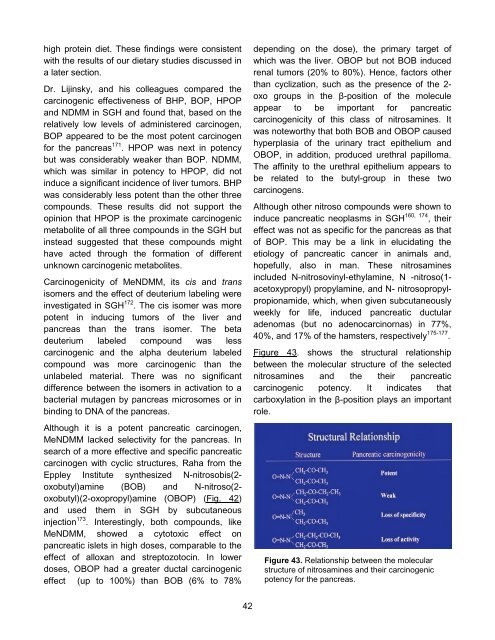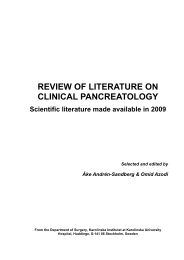Download PDF - The Pancreapedia
Download PDF - The Pancreapedia
Download PDF - The Pancreapedia
You also want an ePaper? Increase the reach of your titles
YUMPU automatically turns print PDFs into web optimized ePapers that Google loves.
high protein diet. <strong>The</strong>se findings were consistent<br />
with the results of our dietary studies discussed in<br />
a later section.<br />
Dr. Lijinsky, and his colleagues compared the<br />
carcinogenic effectiveness of BHP, BOP, HPOP<br />
and NDMM in SGH and found that, based on the<br />
relatively low levels of administered carcinogen,<br />
BOP appeared to be the most potent carcinogen<br />
for the pancreas 171 . HPOP was next in potency<br />
but was considerably weaker than BOP. NDMM,<br />
which was similar in potency to HPOP, did not<br />
induce a significant incidence of liver tumors. BHP<br />
was considerably less potent than the other three<br />
compounds. <strong>The</strong>se results did not support the<br />
opinion that HPOP is the proximate carcinogenic<br />
metabolite of all three compounds in the SGH but<br />
instead suggested that these compounds might<br />
have acted through the formation of different<br />
unknown carcinogenic metabolites.<br />
Carcinogenicity of MeNDMM, its cis and trans<br />
isomers and the effect of deuterium labeling were<br />
investigated in SGH 172 . <strong>The</strong> cis isomer was more<br />
potent in inducing tumors of the liver and<br />
pancreas than the trans isomer. <strong>The</strong> beta<br />
deuterium labeled compound was less<br />
carcinogenic and the alpha deuterium labeled<br />
compound was more carcinogenic than the<br />
unlabeled material. <strong>The</strong>re was no significant<br />
difference between the isomers in activation to a<br />
bacterial mutagen by pancreas microsomes or in<br />
binding to DNA of the pancreas.<br />
Although it is a potent pancreatic carcinogen,<br />
MeNDMM lacked selectivity for the pancreas. In<br />
search of a more effective and specific pancreatic<br />
carcinogen with cyclic structures, Raha from the<br />
Eppley Institute synthesized N-nitrosobis(2oxobutyl)amine<br />
(BOB) and N-nitroso(2oxobutyl)(2-oxopropyl)amine<br />
(OBOP) (Fig. 42)<br />
and used them in SGH by subcutaneous<br />
injection 173 . Interestingly, both compounds, like<br />
MeNDMM, showed a cytotoxic effect on<br />
pancreatic islets in high doses, comparable to the<br />
effect of alloxan and streptozotocin. In lower<br />
doses, OBOP had a greater ductal carcinogenic<br />
effect (up to 100%) than BOB (6% to 78%<br />
42<br />
depending on the dose), the primary target of<br />
which was the liver. OBOP but not BOB induced<br />
renal tumors (20% to 80%). Hence, factors other<br />
than cyclization, such as the presence of the 2oxo<br />
groups in the β-position of the molecule<br />
appear to be important for pancreatic<br />
carcinogenicity of this class of nitrosamines. It<br />
was noteworthy that both BOB and OBOP caused<br />
hyperplasia of the urinary tract epithelium and<br />
OBOP, in addition, produced urethral papilloma.<br />
<strong>The</strong> affinity to the urethral epithelium appears to<br />
be related to the butyl-group in these two<br />
carcinogens.<br />
Although other nitroso compounds were shown to<br />
induce pancreatic neoplasms in SGH 160, 174 , their<br />
effect was not as specific for the pancreas as that<br />
of BOP. This may be a link in elucidating the<br />
etiology of pancreatic cancer in animals and,<br />
hopefully, also in man. <strong>The</strong>se nitrosamines<br />
included N-nitrosovinyl-ethylamine, N -nitroso(1acetoxypropyl)<br />
propylamine, and N- nitrosopropyl-<br />
propionamide, which, when given subcutaneously<br />
weekly for life, induced pancreatic ductular<br />
adenomas (but no adenocarcinornas) in 77%,<br />
40%, and 17% of the hamsters, respectively 175-177 .<br />
Figure 43. shows the structural relationship<br />
between the molecular structure of the selected<br />
nitrosamines and the their pancreatic<br />
carcinogenic potency. It indicates that<br />
carboxylation in the β-position plays an important<br />
role.<br />
Figure 43. Relationship between the molecular<br />
structure of nitrosamines and their carcinogenic<br />
potency for the pancreas.












